Resisting Public Space Surveillance: Fostering privacy and anonymity in the age of mass video and facial recognition surveillance

Surveillance technology in the public space is being used for illegitimate purposes such as to dissuade social protests. The unliability of facial recognition survillance have led to the wrong detention of innocent people, having a disparate impact on female, non-caucasian, trans or non-binary population. Join us to explore how we can expose and fight back this use of public space surveillance.
When the need to fight back public space surveillance becomes primal there are many possible paths to resist: legal actions, advocacy, between others. Join us for this dynamic workshop lead by Santiago Narváez who will help us collectively answer:
- How can we resist?
- Do we even need public space surveillance as it is today?
- How can we analyse public space surveillance systems and fight back their normalization?
- Can we reinvent public space surveillance?
- What limits and controls could we establish to attain surveillance systems that effectively protect our rights and be effective pursuing legitimate aims?
Santiago Narváez is a researcher at R3D, based in Mexico City which focuses on defending digital rights in Mexico. Narvaez surveils the people that are surveilling us, by researching privacy and surveillance. When he is not doing requests for information or analyzing databases, he composes music and plays mid field in R3D soccer team.
>> Check out notes from other sessions here
Notes
Here is the Slide Deck Used for this presentation
- Clearview AI is a secretive organization that is providing facial recognition software to authorities.
- University of Chicago creating counter tools to Clearview AI. https://sandlab.cs.uchicago.edu/fawkes/
- Sunglasses that help with this: https://www.reflectacles.com/
- Fashion against surveillance https://adversarialfashion.com/
- Artist in france capturing all the images of police officer as art of resistance. https://paolocirio.net/work/capture/
- OpenOversight: A public, searchable database of law enforcement officers. https://openoversight.lucyparsonslabs.com/
- CV Dazzle explores how fashion can be used as camouflage from face-detection technology, the first step in automated face recognition. It is a concept and strategy, not a pattern or product, and it is always designed relative to a specific algorithm and unique to each face. https://cvdazzle.com/
Introduction
The concept of public space can be understood in many ways. For me for a place to be public it has to be inclusive and open to political discussions. In this definition a public space is not tied to a specific place but to the practices that take place in it.
I like this definition because it is useful to think about the dynamics of surveillance in public space and the underlying power relations. Surveillance can be used as a mechanism that in a sense can be used to “privatize” public space. It is so when surveillance is used to exclude access to public space to certain people (homeless, peddlers, street musicians, and even people with certain physical traits or style) or to suppress protests, by avoiding them to happen, by acting as a chilling effect, or being used for recognizing and harassing protesters.
Most recently we have the example of police in the United States using facial recognition to identify and later on harass protesters of the black lives matter movement. This kind of use of surveillance is common in a context of governance where governments act as administrators of dissent, punishing marginalized populations when they transgress the systemic inequalities, instead of reducing or such inequalities.
Public space surveillance has also been used to define risk and antisocial behavior, focusing on such crimes and leaving others out such as corporate crimes, white collar crimes, and state violence, deepening oppression from the powerful to the powerless.
Resisting public space surveillance
For all the negative impacts surveillance has on the exercise of our rights and how it is used to oppress and control, how can we resist public space surveillance?
I take the definition of public space surveillance form Roy Coleman & Michael McCahill’s book “Surveillance & Crime” as:
“Any active behaviour by individuals or interest groups that opposes the collection and processing of personal data, either through the micro-practices of everyday resistance to defeat a given application, or through political challenges to wider power relations which contest the surveillance regime per se.”
I find useful the distinction Coleman and McCahill do on everyday resistance and resistance through political challenges. Each type of resistance deals with power relations that I've talked about in different ways.
a. Everyday resistance
- Avoidance strategies: Evade the gaze of surveillance.
- Distorting moves: attempt to ‘manipulate the surveillance collection process such that, while offering technically valid results, invalid inferences are drawn from a test or inspection of an attribute or behaviour’.
- Distorting in 4 phases of facial recognition.
- Modification of physical traits/movements in order to not be identified.
- Use of makeuphttps://www.theguardian.com/world/2020/feb/01/privacy-campaigners-dazzle-camouflage-met-police-surveillance
- Blocking moves: physically block access to the communication or to render it unusable.
- Hoodies*
- Blocking camera scope.
- Masks.
- Lasers.
- Umbrellas.
- Spray paint.
- Breaking moves: https://www.theatlantic.com/technology/archive/2019/08/why-hong-kong-protesters-are-cutting-down-lampposts/597145/
- Counter surveillance: Use of surveillance to register police abuses.
b. Political challenges
Political challenges to surveillance are more contextual (as power relations are different in most circumstances) and harder to define as they are tough on complex issues that can shift. I think of them as ways that attack underlying narratives of how useful and needed public space surveillance is (for example privacy vs security), revealing the ways in which it is being used to oppress or to make us more vulnerable, and offering narratives that diverge from the ones that support the actual power relations.
In R3D we think this is central to fighting all types of surveillance, not only public space surveillance.
Some of the questions one can ask to take some steps in this direction are:
- How can we analyse public space surveillance systems and fight back their normalization?
- How useful is surveillance?
- What interests does surveillance serve (political, geopolitical, commercial, social, etc,)?
The answers then can be used to act against surveillance and attack its legitimacy in democratic arenas seeking to movilize people and have an effect on decision makers, highering the stakes for choosing surveillance over the rights of the people.
Of course it is easier said than done.
In this way of action I can speak of two undergoing projects we at R3D are conducting on public space surveillance in Mexico City and the use of Facial recognition in public space surveillance in the country, aimed at challenging this type of surveillance.
CDMX_CCTV (no name yet) Joint research with Data Cívica!
Counter attack government’s narrative in Mexico City towards the utility of the public space surveillance system. There are more than 14 thousand cameras installed in the city. Each government since 2009 has proposed increasing the number of cameras to fight growing insecurity, yet there is no evidence such a system has helped in preventing and/or investigating crime. There is also a sustained in belief that surveillance is a useful and easy solution to deep and complex social issues, yet there is limited evidence that shows that surveillance is even useful in dealing with them. estudios empíricos.
For example, a review of 44 research studies on CCTV schemes in the UK by the Campbell Collaboration in 2009 found that they do have a limited impact on crime overall, but are most effective in cutting vehicle crime in car parks (The Guardian, 18 May 2009). In an earlier survey of research it was suggested that there ‘is little substantive research evidence that CCTV works’ as either a crime prevention or anxiety reducing tool (NACRO, 2002: 6).
We conducted research together with Data Cívica (a human rights data NGO), based on finding whether the video surveillance system was effective in crime prevention, investigation and the cost of it. The main takeaways where that:
- The evidence does not show a significant decrease in crimes committed after the installation of video cámeras.
- The system is not really being used to investigate crimes, less than 1 percent of the crimes investigation that could profit from videos is using them.
- Other policies different from extensive public space surveillance should be explored, given the previous results and the large expenditure.
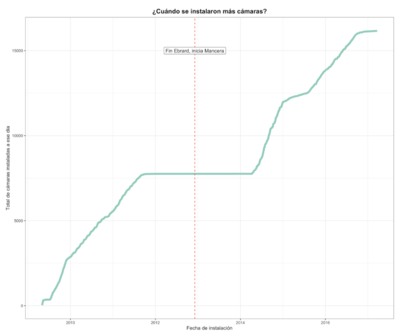
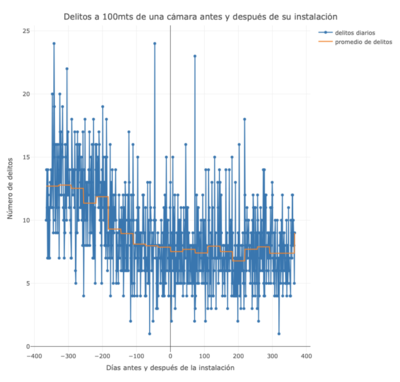
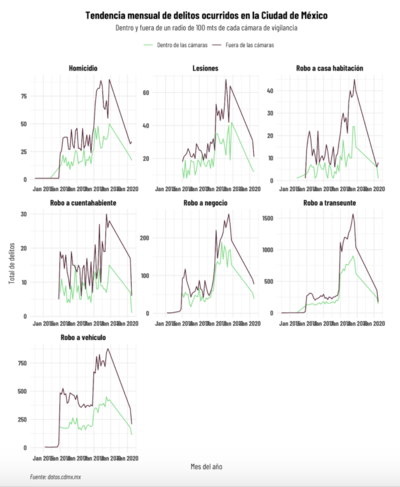
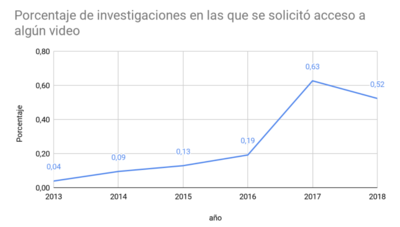
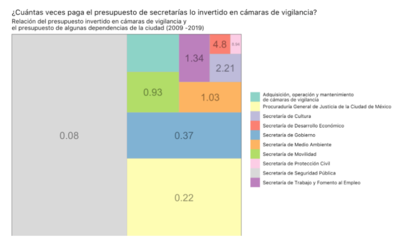
No nos vean la cara (anti facial recognition campaing)
The campaign is focusing on a first step in communicating how facial recognition is being used by the government in Mexico and the risks of its use.
We have conducted extensive research through FOIA requests to local and federal agencies that could be using facial recognition technologies.
No transparency about its use, lack of understanding of how technology works and the risks involved with its use.
We presented a demand (amparo) against its use in the northern state of Coahuila, where the government has declared its use has led to multiple detentions. In our demand we stated that the use of facial recognition surveillance in the state of Coahuila violates the right to privacy, personal data protection, freedom of expression, reunion freedom, legality, due process, presumption of innocence and right to non-discrimination.
Reinventing public surveillance
Surveillance can be a useful and desirable tool in some cases as it can make us more secure. This depends on the way in which surveillance is used. Limits and controls are necessary to avoid misuse, and abuse. From a human rights perspective, surveillance needs to be necessary, proportionate, limited in order to respect our rights. We should add to this analysis others on the impact of surveillance in the exercise of political rights, and how it impacts marginalized populations, on discrimination and other.
Guidelines for public space surveillance that respect human rights
Here are guiding principles taken from different works that systems of public space surveillance should follow in order to respect human rights. These are not exhaustive, as everything else in the presentation is open to debate and further contributions.
Creation and design of public space surveillance systems:
- The public video surveillance system only to further a clearly articulated law enforcement purpose: statement of the legitimate purpose of the system should be clear, and provide means to assess the system and its use.
- Ensure that public video surveillance systems are capable of effectively achieving their articulated purposes.
- Compare the cost of a public video surveillance system to alternative means of addressing the stated purposes of the system.
- Assess the impact of a public video surveillance system on human rights: Specially the right to privacy, personal data protection, freedom of expression, reunion freedom, legality, due process, presumption of innocence and right to non-discrimination.
- Design the scope and capabilities of a public video surveillance system to minimize its negative impact on human rights
- Create technological and administrative safeguards to reduce the potential for misuse and abuse of the system.
- Ensure that the decision to create a public video surveillance system, as well as major decisions affecting its design, are made through an open and publicly accountable process.
- Justification of placement of cameras in public space: The location of cameras should respond to clear criteria defined by the law that is coherent with the purpose the system follows, together with input from people that live in the area.
Regulation of use of the public space surveillance system
- “Record” footage from public video surveillance systems only to the extent necessary to further the system’s stated purposes.
- Under most circumstances, individuals may be “tracked” or “identified” by a public video surveillance system only pursuant to a warrant.
- Employ technological and administrative safeguards to reduce the potential for misuse and abuse of the system.
- Prohibit, to the extent possible, sharing of public video surveillance data with third parties, including private litigants, and restrict sharing with other governmental entities.
- Establish mechanisms to protect the rights of identifiable individuals captured on video surveillance data.
- Provide appropriate remedies for those harmed by misuse or abuse of public video surveillance systems.
- Notice subjects of surveillance: surveilled individuals identified or followed should be noticed at a moment where the investigations are not affected by such notice.
Accountability
- Develop rules that ensure there is public information to assess and effectiveness of the system.
- Establish effective mechanisms that assure compliance.
- Periodic review of effectiveness and scope of surveillance.
What about facial recognition public space surveillance systems?
In R3D we believe that as of today such systems should be banned.